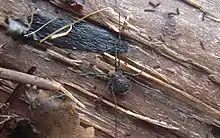| Dendrolasma | |
|---|---|
 | |
| Dendrolasma mirabile | |
| Scientific classification | |
| Domain: | Eukaryota |
| Kingdom: | Animalia |
| Phylum: | Arthropoda |
| Subphylum: | Chelicerata |
| Class: | Arachnida |
| Order: | Opiliones |
| Family: | Nemastomatidae |
| Subfamily: | Ortholasmatinae |
| Genus: | Dendrolasma Banks, 1894 |
| Type species | |
| Dendrolasma mirabile Banks, 1894 | |
| Diversity | |
| 2 species | |
Dendrolasma is a genus of harvestmen in the family Nemastomatidae with two described species (as of 2023).[1][2][3] Both species are found in the western coast of North America.[1][4][5][6] An overview of their taxonomy was provided by Schönhofer (2013).[7]
Description
The genus Dendrolasma was described in 1894 by Nathan Banks[8] with the type species Dendrolasma mirabile. In the past, additional species were included but have since been placed in Asiolasma or Cladolasma.
Species
These two species belong to the genus Dendrolasma:
- Dendrolasma dentipalpe Shear & Gruber, 1983[9] – USA (California)
- Dendrolasma mirabile Banks, 1894[8] – USA (Washington, etc); Canada (British Columbia, etc)
Etymology
The genus is neuter. The appropriate gender agreement was originally overlooked by Banks when describing "D. mirabilis", but the suffix was subsequently amended to the neuter "mirabile" by Martens (1978), and adopted by later authors.
References
- 1 2 "Dendrolasma". Kury, A. et al. (2023). WCO-Lite: World Catalogue of Opiliones. Retrieved 2023-12-27.
- ↑ "Dendrolasma". Catalogue of Life. Retrieved 2023-12-27.
- ↑ "Dendrolasma Report". Integrated Taxonomic Information System. Retrieved 2023-12-27.
- ↑ "Dendrolasma". iNaturalist. Retrieved 2023-12-27.
- ↑ "Dendrolasma". GBIF. Retrieved 2023-12-27.
- ↑ "Dendrolasma genus Information". BugGuide.net. Retrieved 2023-12-27.
- ↑ Schönhofer, A.L. (2013). "A taxonomic catalogue of the Dyspnoi Hansen and Sørensen, 1904 (Arachnida: Opiliones)". Zootaxa. 3679 (1): 1–68. doi:10.11646/zootaxa.3679.1.1. PMID 26146693.
- 1 2 Banks, N. (1894). "The Nemastomatidae and Trogulidae of the United States. I." Psyche. 7 (213): 11–12. doi:10.1155/1894/37947.}
- ↑ Shear, W.A.; Gruber, J. (1983). "The opilionid subfamily Ortholasmatinae (Opiliones, Troguloidea, Nemastomatidae)". American Museum Novitates (2757): 1–65. ISSN 0003-0082.}
External links
 Media related to Dendrolasma at Wikimedia Commons
Media related to Dendrolasma at Wikimedia Commons Data related to Dendrolasma at Wikispecies
Data related to Dendrolasma at Wikispecies
This article is issued from Wikipedia. The text is licensed under Creative Commons - Attribution - Sharealike. Additional terms may apply for the media files.